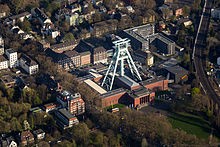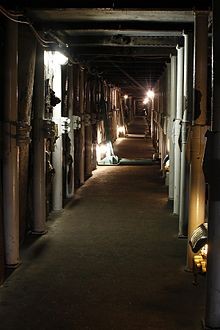German Mining Museum

The German Mining Museum as Deutsche Bergbau-Museum Bochum (DBM) is with around 365.700 visitors (2012) per year, one of the most visited museums in Germany. It is the world's biggest mining museum and at the same time research institute for archaeo-mentallurgy and Archaeometry as well as documentation centre and archive in the area of mining history.
Surface exhibitions of circa 12.000 m² and an original viewing colliery below the museum site with ca. 2,5 km route length (right now, 850 m accessible) gives the visitor insights in the mining world. The research emphasis of the scientists are history and technique of the mining nature as well as documentation and preserving of cultural heritage. the museum is a research facility member of the Leibniz-Association.
The beginning of the museum goes back to the 1860ties, when the Westfälische Berggewerkschaftskasse (WBK) set up a permanent exhibition of mining utensils in Bochum, which served mainly mining school lessons. At the end of the 1920ties, representatives of the WBK and the city of Bochum developed ideas to establish a mining museum, which is open to the public.
The founding contract for the history museum of mining was concluded between the city of Bochum and the WBK on the 1st of April 1930. The old livestock slaughterhouse of the closed Bochum abattoir served as the museum first hall. In 1935, on the abattoir site, a new museum's building with additional exhibition area was designed after plans by Fritz Schupp and Heinrich Holzapfel. Work of the viewing colliery started in the year 1936.
In the year 1943, the not yet finished museum works were more or less completely destroyed by allied air raids, the viewing mine was rebuilt as an air raid shelter.
In 1946, the museum was reopened with a small exhibition. In the 1950ties, the museum was rebuilt and extended and in 1960, the routes of the viewing mine were extended to a total length of 2.510 metres.
During the years 1973 and 1974, the winding tower of the closed mine Germania in Dortmund-Marten was relocated to Bochum.
In the year 1976, The until then the Mining Museum was renamed to German Mining Museum Bochum (DBM). In 1977, it was recognised by the Federal Government Commission for educational planning and research funding Bund-Länder-Kommission für Bildungsplanung and Forschungsförderung (BLK) (Federal Government Commission for educational planning and research funding) as research museum and admitted into the common research funding of the federal government and federal states. Since then, it belongs to the institutes of the Blue List.
On the 6th of December 2009, the Black Diamond, an extension for special exhibitions was opened. The building with its striking and under solar exposure sparkling facade, presents itself as an intersection of a mining gallery system.

On an exhibition surface of 12.000 square metres, the visitor will learn about the development of mining from pre-historic times to today. The different technical areas of mining as well as its cultural and social aspects are being thematic-chronological depicted.
A system of routes and braces at a depth of 20 metres and a length of around 2,5 kilometres illustrates more or less realistically the conditions, the tunnel drive and the mining of coal as well as some security aspects. But the routes have never been used for mining of mineral resources and were designed for demonstration purposes only.
Since 1995, a model of the last German mine horse Tobias, can be seen at the viewing mine.
The winding tower, originally part of the mine Germania in Dortmund-Marten, offers a wide view over Bochum and the Ruhr area in good weather.
(The original text stems from the article of the Free Encyclopaedia Wikipedia http://de.wikipedia.org/wiki/Deutsches_Bergbau-Museum_Bochum)

